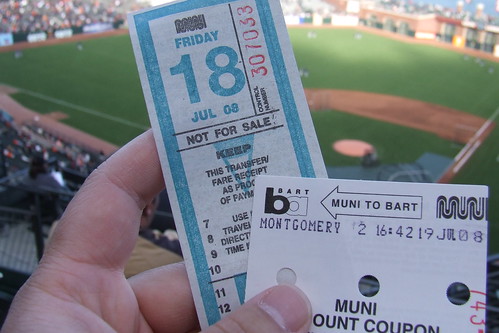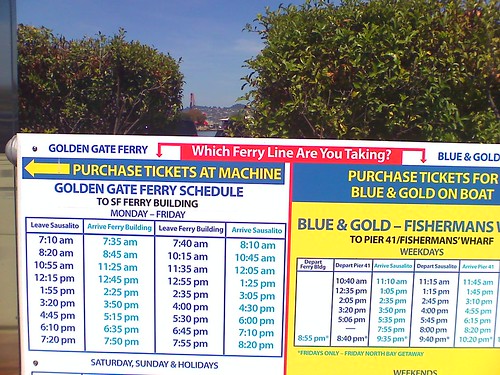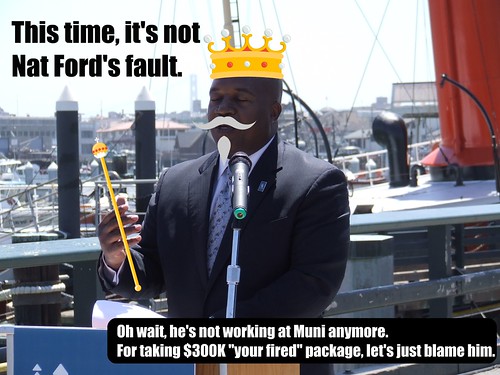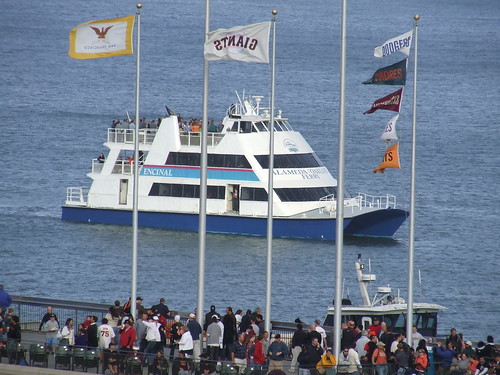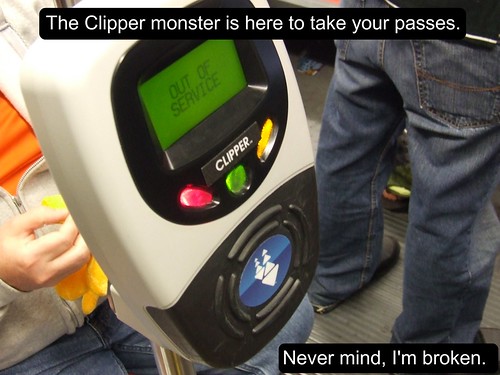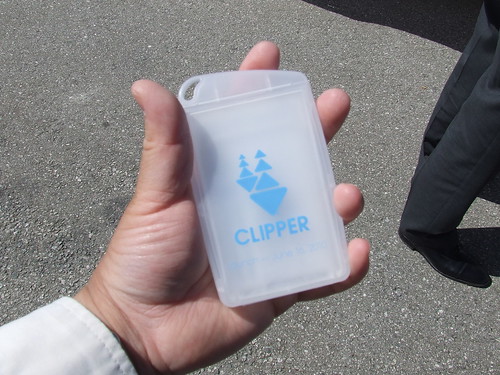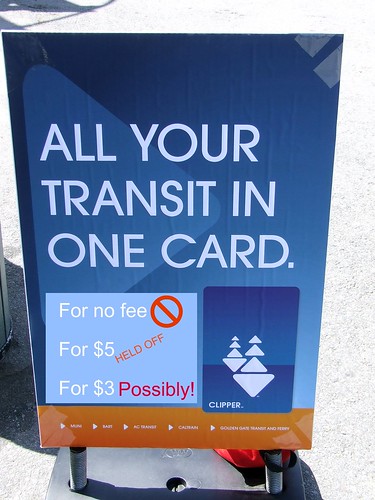
Ever since Clipper started in mid June 2010, the cards have been distributed for free to the public to use. Over the past year, Clipper had to change the rules as local news media told the public how to abuse Clipper's negative balance policy (
read my reaction to it) with just a brand new card with $2 on it. Clipper decided to
raise the minimum new card balance requirement to $5, but never pursued a $5 card acquisition fee.
It wasn't until the new Muni gates came in and I learned that the card acquisition fee would be waived until June 30, 2011. This meant the end of free cards. Now that it is September, the MTC, nor Clipper has taken any action to tacking on the $5 fee, and now I found out why.
If you don't want to read all the material, go to the "Quick Summary" section near the bottom of this blog post.The Title VI Draft DocumentThe MTC published their findings as they are required to do so under
Title VI of the Civil Rights Act of 1964 to make sure they are not discriminating against people protected under it while the Clipper card program is in use and transitioning passes and tickets to the blue card. If you don't know what could happen if Title VI is not done, just look at BART's AirBART people mover project, they lost millions in federal dollars by not doing an analysis and now will have to absorb that cost themselves.
While this is only a draft to be reviewed by the Operations Committee this Friday, it does give insight into why the $5 fee has continued to be waived after their established deadline of June 30, 2011.
Read the document here (PDF file).
A little history...Back in 2006, TransLink (this was prior to Clipper) was in full operation on AC Transit and Golden Gate Transit & Ferry. The new dark green card had an acquisition fee of $5 for any passenger interested in a card. The fee was used to offset the cost of acquiring the card from the manufacturer and defeated the purpose of abusing the card's negative balance policy of $5. The card was issued for free to those signing-up for autoload or had it connected to a pre-tax commuter benefit program (since the card was linked to someone's name, they knew who owed a debt to TransLink). They also set aside a quarter of a million cards for transit agencies to give out as free promotional items.
In April 2010 (just two months prior to changing name to Clipper), the MTC and members of the TransLink consortium agreed to a three month free period for people to obtain cards (no $5 acquisition fee), and also agreed to waive the fee permanently for all seniors and youth transit passengers.
In August 2010 (a month after changing to Clipper), the MTC agreed upon giving out Clipper cards with no $5 acquisition fee until the end of the fiscal year (June 30, 2011) to promote people to switch, and especially their plans to have all transit passes go Clipper only would cause possible hardship to passengers not willing to fork $5 for a card.
Today...Sometime in June or July 2011, the MTC was going to reinstate the fee, but had to hold back because of Title VI. The MTC feels that reinstating the $5 acquisition fee "could present a barrier to acquiring Clipper cards for persons protected by Title VI, and the reviews recommend eliminating the fee permanently." (Page 16 0f 30 of the draft document).
The MTC argues the $5 fee is necessary to address these six objectives for the program (directly quoted from the document, page 16 of 30):
- Cover the cost of the cards;
- Discourage fraudulent abuse of the negative balance feature;
- Discourage the casual disposing or loss of cards;
- Discourage hoarding of cards;
- Minimize potential barriers to adoption of Clipper; and
- Continue to support/encourage customer adoption of the Clipper card.
But they also had to take these two points into consideration as well in deliberating of reinstating the $5 fee:
- Since the Clipper card is reusable and will last at least three years with good care, a regular transit rider would use it enough times to justify most of its cost (compare a transit agency's cost of purchasing from a company that produces its monthly passes vs. how much it costs for the MTC to obtain a card that costs more than one paper pass, but can last years).
- For business reasons, having the card fee would help people to retain their cards, offset the cost of procuring them, and stops the abuse of the negative balance feature.
The MTC also noted that the Clipper program has some substantial benefits in the interest of the public that a $5 would just be a barrier to deny people. Some of them include automatic e-transfers, riding multiple agencies with one card, universal cash fund, multiple passes, etc.
Waiving the $5 fee did come with some harsh realities...1: Hoarding the cards was a problem because the cards was initially free with no minimum purchase required to obtain one. Managers at Walgreens locations said people asking for free cards with no initial value loaded was taking away their staff's time. The MTC instated a $2 minimum e-cash load for every new card obtained by the customer. Hoarding also became a problem with abusing the negative balance feature, as noted below.
2: Abusing the negative balance feature came at a heavy cost when the news media told people now to abuse the negative balance feature at the expense of taxpayers. People could obtain a new card with just $2 of e-cash and ride any transit agency that cost more than the value on the card's chip and just throw it away. The MTC debated on what to do, including eliminating the negative balance policy, but instead decided to raise the e-cash minimum to $5. Deciding to raise it to $5 was a good idea as the abuse started to go down.
The MTC's plan...The proposal is to change the acquisition fee to $3 ($2 less than originally proposed) and a $2 minimum load requirement ($3 less than what is current). This means a minimum of $5 will need to be handed over by the customer to obtain a card and get a starting e-cash balance.
The commission believes this is an appropriate adjustment that's right in the middle: The card's not free, nor will it have a big impact to those covered under Title VI. The MTC wants to make people change their minds about Clipper by not making the cards something easily disposable, but make it worth of some kind of value (the $3 acquisition fee). Clipper has already given away 1.1 million cards for free, by treating it as a throw away product, it's not sustainable and costly to taxpayers. The new fee and minimum balance would support the operational needs.
In order to comply with Title VI, the MTC will have to go out into the communities and conduct research to see if the $3 fee is feasible. After compiling the feedback, the MTC will make the final call on the fee.
Quick SummaryFor those of you not wanting to read all the details, here's just a quick one you can read:
- The $5 acquisition fee for Clipper has been waived for a long time.
- MTC wants to activate the fee because of people abusing the Clipper cards (e.g. negative balance benefit).
- The $5 fee and an existing $5 minimum e-cash balance (total of $10) may be a negative impact on certain people covered under federal law.
- Continuing to give it for free will be very costly to taxpayers.
- MTC takes the middle ground, wants to charge $3 for new card, plus a $2 minimum e-cash purchase (total of $5). Helps to cover the cost of procuring the cards and any other operational costs.
- MTC can't take action until they do community outreach.
Akit's OpinionI'm no fan of giving out plastic Clipper cards for free. The negative balance policy and abusing it is the worst problem of all as that encourages people to buy multiple cards with the minimum value and forces us taxpayers to pay more. Plus, issuing over a million cards when a portion gets thrown away after one use is not very sustainable.
Sure, I understand that Title VI is important and charging a high fee to obtain a card would not be feasible. I initially suggested
the acquisition fee should be the highest one-way transit fare for whichever agency is participating in the program, but Title VI would kick that straight in the ass.
The mentality of people needs to change by making people value their cards and should keep them. Even at SF State, students, faculty, and staff value their campus ID because the fee is $22 to obtain a replacement, and the card is used in so many ways, from borrowing library books to accessing the campus swimming pool. Clipper can't charge a high fee for obtaining the cards, so they are going with something in the middle, $3 card fee and $2 minimum e-cash load.
The $3 card acquisition fee will cover the procurement of the cards valued at $2.22 a card, but will only cover 78 cents of $1.31 for the distribution of them (as per MTC documents, page 17 of 30). This means by taking the middle ground, they will recover most of the cost of the card, but a small amount will be paid by us taxpayers. Even then, the little remaining cost can be written off if a passenger uses it for the multi-year life expectancy of the card when compared to cost a transit agency must pay to procure and distribute monthly passes and paper transfers in a same time period.
Even then, I still believe people will continue to abuse the negative balance policy because they'll feel that while there is a $3 acquisition fee and just $2 in e-cash, as long as the passenger takes a one-way trip that costs more than $5, the card is just another one in the trash.
If the MTC wants to take true action, yes, enforce the $3 acquisition fee with a minimum balance to meet Title VI, but only allow people who register their card with Clipper to be allowed to have the negative balance. This keeps track of who abuses their card privileges and makes people become responsible for paying that negative balance, or if it gets too high with multiple cards, the MTC can act like FasTrak abusers, making them go through collections. For BART, it's easy to stop the negative balance policy by modifying their exitfare machines to force those passengers to pay-up the difference before being allowed to exit the system.
